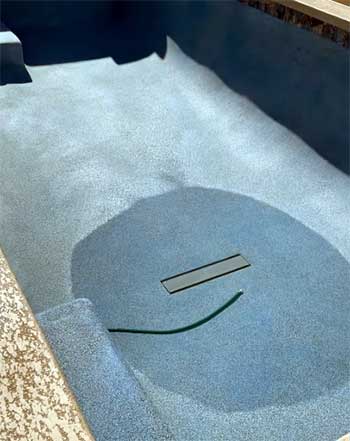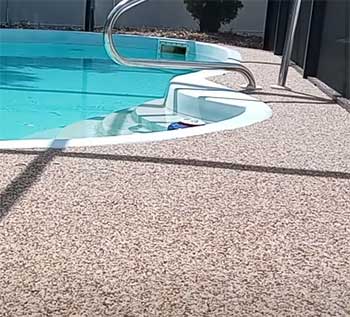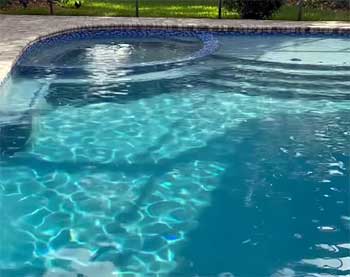I’ve spent countless summers lounging by pools, and let me tell you, the finish makes all the difference. When I decided to upgrade my backyard oasis, I faced a tough choice: Pebble Tec or Pebble Sheen?
Both are top-tier aggregate finishes from Pebble Technology International, promising durability and beauty. My goal here is to walk you through their features, weigh the pros and cons, and help you decide which suits your pool.
Whether you’re building new or resurfacing, this guide will clarify what sets these finishes apart and why it matters to you.
A Brief Comparison Table
| Feature | Pebble Tec | Pebble Sheen |
| Pebble Size | Larger pebbles, earthy texture | Smaller, ground pebbles, refined feel |
| Texture | Rougher, more natural | Smoother, less abrasive |
| Durability | 20+ years with proper maintenance | 20+ years with proper maintenance |
| Color Options | 18 vibrant, fade-resistant colors | 16 refined, shimmering colors |
| Cost | $8–$12 per sq. ft. | $10–$14 per sq. ft. |
| Maintenance | Low, resists stains | Slightly higher, needs regular cleaning |
| Aesthetic Appeal | Natural, rugged, oasis-like | Elegant, polished, modern |
| Non-Slip Quality | Excellent traction | Good traction, less aggressive |
| Best For | Those prioritizing grip and rugged look | Those wanting smoother, refined feel |
This table gives you a quick snapshot, but stick with me as I break down the details to help you make an informed choice.
My Journey Into Pool Finishes
When I started researching pool finishes, I was overwhelmed by the options. Plaster? Quartz? Pebble?
I quickly zeroed in on Pebble Tec and Pebble Sheen because they kept popping up as the gold standard for aggregate finishes. As someone who loves a pool that looks like a natural lagoon but also feels good underfoot, I needed to understand what made these two different.
I spent hours talking to pool builders, reading forums, and even visiting friends’ pools to see these finishes in action. Here’s what I learned about their key features and how they stack up.
What Is Pebble Tec?

Pebble Tec is the original aggregate pool finish, pioneered by Pebble Technology International in 1986. It’s a blend of cement, sand, and larger pebbles sourced from riverbeds and beaches worldwide.
The process involves applying this mix to the pool’s surface, then acid-washing it to expose the pebbles, creating a textured, natural look. I was drawn to its rugged charm—think of a mountain stream or a Caribbean cove.
It’s available in 18 colors, from deep blues to earthy tans, and often includes additives like seashells for extra sparkle.
The larger pebbles give Pebble Tec its signature earthy texture, which is both a strength and a consideration. It’s incredibly durable, often lasting over 20 years with proper care, and its non-slip surface is ideal for safety.
But that texture can feel rough, especially if you’re barefoot for hours. I noticed this when I visited a friend’s Pebble Tec pool—the grip was fantastic, but my kids complained about their feet after a long swim.
Pros of Pebble Tec
Let’s start with why Pebble Tec might steal your heart. First, its durability is unmatched. I’ve heard stories of Pebble Tec pools looking pristine after 25 years, and my research backs this up. The larger pebbles and robust cement mix resist stains, fading, and impacts better than traditional plaster.
If you maintain your pool’s chemistry—keeping pH, alkalinity, and calcium levels balanced—you’re set for decades.
The natural aesthetic is another big win. Pebble Tec transforms your pool into a backyard oasis that feels like a slice of nature. The 18 color options let you customize, whether you want a deep ocean blue or a sandy beige. I was particularly smitten with the “Tahoe Blue” shade, which gave a friend’s pool a lagoon-like vibe.
Safety is a huge factor for me, especially with kids around. Pebble Tec’s rough texture provides excellent traction, reducing the risk of slips. I tested this myself, walking barefoot on a wet Pebble Tec deck—it felt like I was glued to the surface.
Plus, it’s low-maintenance. Unlike plaster, which stains easily, Pebble Tec hides chemical residue and requires minimal scrubbing.
Cons of Pebble Tec
But it’s not all sunshine and pool floats. The biggest drawback I noticed is the texture. Those larger pebbles can be tough on sensitive feet, especially for kids or anyone spending hours in the pool.
I read forum posts where some owners called it “sandpaper-like,” though I think that’s a bit extreme. Still, if comfort is your top priority, this could be a dealbreaker.
Another con is the potential for algae to hide between the pebbles. If your pool chemistry goes off-balance, black algae can nestle into the crevices, making it a pain to scrub out.
I spoke to a pool tech who said it took two months to clear an algae bloom from a neglected Pebble Tec pool. Regular maintenance prevents this, but it’s something to keep in mind.
Finally, Pebble Tec isn’t cheap. At $8–$12 per square foot, it’s pricier than plaster, which runs about $4 per square foot. For my 1,000-square-foot pool, that’s a $4,000–$8,000 difference. If you’re on a tight budget, this might push you toward alternatives.
What Is Pebble Sheen?

Pebble Sheen, a newer offering from the same brand, takes the Pebble Tec concept and refines it.
It uses smaller, lightly ground pebbles, resulting in a smoother, more polished surface.
The finish still retains that natural, aggregate look but feels less abrasive.
Available in 16 colors, Pebble Sheen has a subtle shimmer, thanks to the finer pebbles reflecting light.
When I saw it at a neighbor’s pool, the water looked vibrant, almost jewel-like, under the sun.
The smoother texture makes Pebble Sheen a favorite for those who want durability without sacrificing comfort. It’s still non-slip, but it’s gentler on the skin.
However, those smaller pebbles mean you might need to clean it more often to keep the colors popping. I found this out when my neighbor mentioned scrubbing their pool every few months to prevent dullness.
Pros of Pebble Sheen
Pebble Sheen won me over with its balance of beauty and comfort. The smaller pebbles create a smoother surface that’s kinder to your feet while still offering good traction.
I walked on a Pebble Sheen pool floor and barely noticed the texture—it felt like a gentle massage compared to Pebble Tec’s grit. This makes it ideal for families or anyone who prioritizes comfort.
The aesthetic is another standout. Pebble Sheen’s finer pebbles catch the light, giving the water a vibrant, shimmering effect. The 16 color options, like “Blue Surf” or “Emerald Bay,” are refined and elegant, perfect for a modern backyard.
I saw a Pebble Sheen pool at sunset, and the water practically glowed.
Durability is on par with Pebble Tec, with a lifespan of 20+ years if maintained well. It’s also stain-resistant and hides chemical residue, though not quite as well as Pebble Tec due to the smaller pebbles. For me, the trade-off for a smoother feel was worth it.
Cons of Pebble Sheen
Pebble Sheen isn’t perfect either. The smoother surface means it needs more frequent cleaning to maintain its vibrant colors. My neighbor mentioned brushing their Pebble Sheen pool every few months to prevent dullness, which is more effort than Pebble Tec requires.
If you’re not diligent, the finish can lose its sparkle over time.
Cost is another hurdle. At $10–$14 per square foot, Pebble Sheen is pricier than Pebble Tec. For my 1,000-square-foot pool, upgrading to Pebble Sheen could cost $2,000–$6,000 more than Pebble Tec. That’s a significant jump if you’re watching your wallet.
Lastly, while Pebble Sheen is non-slip, it’s slightly less grippy than Pebble Tec. I didn’t notice a huge difference, but if you have a pool with lots of roughhousing or steep slopes, Pebble Tec might be the safer bet.
Key Differences Between Pebble Tec And Pebble Sheen
- Texture and Comfort: A Personal Take

Texture was a big deal for me. I wanted a pool that felt good to walk on but didn’t compromise safety.
Pebble Tec’s larger pebbles give it a rugged, almost rocky feel.
It’s great for traction, but after a few hours, my feet felt tender.
I remember my kids complaining after a pool party, saying the bottom “hurt their toes.”
Pebble Sheen, on the other hand, felt like a happy medium. The smaller pebbles were still textured enough to prevent slips but didn’t leave my feet begging for mercy.
If you’re like me and value comfort for long swims, Pebble Sheen might edge out.
- Aesthetic Appeal: What’s Your Vibe?
Your pool’s look sets the tone for your backyard. Pebble Tec’s earthy, natural vibe is perfect if you want a rugged, organic feel—like swimming in a river or lake. The larger pebbles create depth and texture, making the water look invitingly wild. I loved how a friend’s Pebble Tec pool blended with their desert landscape, almost like it belonged there.
Pebble Sheen, however, leans toward elegance. The smaller pebbles and subtle shimmer give it a polished, modern look. I saw a Pebble Sheen pool at a home show, and it screamed sophistication, like something you’d find at a high-end resort.
If your backyard is more “chic retreat” than “wild escape,” Pebble Sheen’s your match.
- Durability and Longevity: Built to Last
Both finishes are built to withstand the test of time, which was a huge relief for me. I didn’t want to resurface my pool every few years like plaster demands. Pebble Tec and Pebble Sheen both boast lifespans of 20+ years with proper care.
I spoke to a pool builder who said he’s seen Pebble Tec pools from the ’90s still looking great, and Pebble Sheen holds up just as well. The key is maintaining balanced pool chemistry—pH between 7.2–7.6, alkalinity at 80–120 ppm, and calcium hardness at 200–400 ppm. Skimp on this, and you risk scaling or pebble loss.
- Maintenance: Keeping It Sparkling
Maintenance was a big factor in my decision. Pebble Tec’s larger pebbles make it forgiving—it hides stains and chemical residue well, so you’re not scrubbing constantly. I found that a quick brush every few weeks kept it looking fresh.
Pebble Sheen, with its smaller pebbles, shows dirt a bit more and needs regular cleaning to maintain its vibrancy. My neighbor with a Pebble Sheen pool said they brush monthly and occasionally use an acid wash to restore the shine.
If you’re low-maintenance like me, Pebble Tec might be easier, but Pebble Sheen’s upkeep isn’t a dealbreaker.
- Cost Considerations: Budgeting for Beauty

Let’s talk money. Pebble Tec costs $8–$12 per square foot, while Pebble Sheen runs $10–$14.
For a standard 1,000-square-foot pool, that’s $8,000–$12,000 for Pebble Tec and $10,000–$14,000 for Pebble Sheen.
Compared to plaster’s $4 per square foot, both are a splurge, but their longevity justifies the investment.
I crunched the numbers and realized that over 20 years, the cost difference between plaster and these finishes evens out, since plaster needs resurfacing every 5–8 years. Still, if your budget’s tight, Pebble Tec saves you a bit upfront.
- Safety and Traction: Keeping It Safe
As a parent, safety is non-negotiable. Pebble Tec’s rougher texture gives it an edge for traction, especially on steps or slopes. I felt confident letting my kids run around a Pebble Tec pool without worrying about slips.
Pebble Sheen is still non-slip, but its smoother surface is slightly less grippy. I tested both by walking on wet surfaces, and while Pebble Sheen felt secure, Pebble Tec was like Velcro. If you have a lively pool with lots of activity, Pebble Tec might be the safer choice.
- Color Options: Setting the Mood
Pebble Tec’s 18 colors range from bold “Midnight Blue” to earthy “Desert Gold.” I loved the variety, especially for creating a natural vibe. Pebble Sheen’s 16 colors, like “Aqua Blue” or “Tropical Breeze,” lean toward a refined shimmer.
I noticed Pebble Sheen’s colors pop more under sunlight, giving the water a vibrant glow. Both let you customize with additives like glass beads for extra sparkle. I leaned toward Pebble Sheen’s “Blue Surf” for its modern flair, but Pebble Tec’s “Tahoe Blue” was a close contender.
- Installation: What to Expect
Both finishes require a certified PebbleTec builder, which ensures quality but limits your contractor options. The process takes about two days: the mix is applied, troweled smooth, and acid-washed to expose the pebbles.
I watched a Pebble Sheen installation at a friend’s house, and the precision was impressive—the crew worked like artists. Pebble Tec’s larger pebbles require a slightly less meticulous exposure process, which can shave a bit off labor costs. Either way, expect a professional job that’s worth the investment.
Making the Choice: What’s Right For You?
Choosing between Pebble Tec and Pebble Sheen depends on your priorities. If you want maximum traction, a rugged look, and minimal maintenance, Pebble Tec is your go-to. It’s slightly cheaper and ideal for high-traffic pools.
If you crave a smoother, more elegant finish that’s still durable but requires a bit more upkeep, Pebble Sheen is the winner. I leaned toward Pebble Sheen for its comfort and polished aesthetic, but I appreciated Pebble Tec’s raw beauty and grip.
Frequently Asked Questions (FAQ)
Yes, if you value a smoother, more refined look and feel. Its durability matches Pebble Tec, but the comfort and elegance justify the higher cost for many.
Its rougher texture can irritate sensitive feet, and algae can hide in crevices if maintenance slips. It’s also pricier than plaster.
Pubble Sheen is a pool finish with smaller, ground pebbles, offering a smoother, more polished look than Pebble Tec while maintaining durability.
Expect $10–$14 per square foot, so a 1,000-square-foot pool costs $10,000–$14,000, depending on labor and additives.
Conclusion: Your Pool, Your Choice
I’ve laid out the ins and outs of Pebble Tec and Pebble Sheen to help you make the best choice for your pool. Both offer stunning durability and beauty, but your decision hinges on what you value most—Pebble Tec’s rugged grip or Pebble Sheen’s smooth elegance.
Think about your budget, maintenance habits, and the vibe you want for your backyard. Whichever you choose, you’re investing in a pool that’ll be the heart of countless memories.
So, what’s your pick? Let’s make your pool the envy of the neighborhood.
